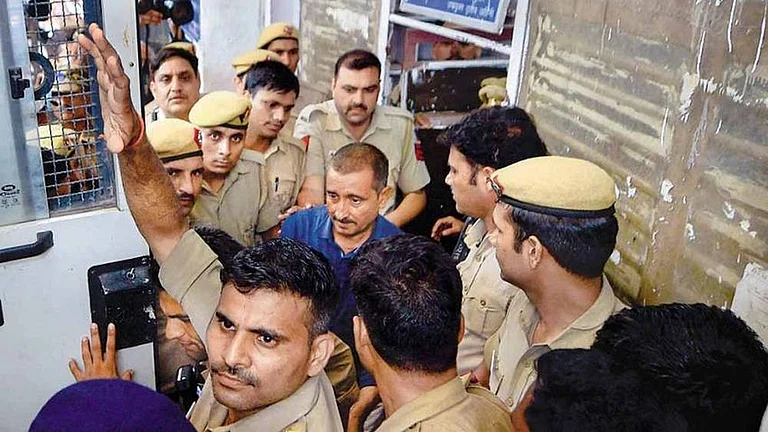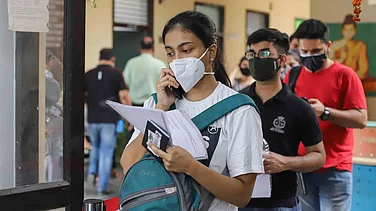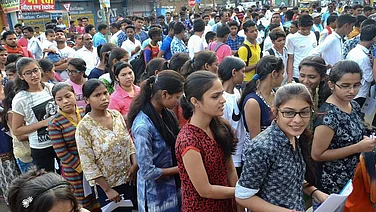‘Science, Commerce or Humanities?’—every teenager is posed with this question upon entering high school. In 2022, almost 42 lakh students picked the science stream. And a majority of them hail from just five states, all located in the southern part of India—Tamil Nadu, Kerala, Andhra Pradesh, Telangana and Karnataka.
Byresh S H was one such student. Hailing from a small town in Kolar, Karnataka, and a student of Expert PU College, Mangaluru, Byresh topped the BSc agriculture stream this year. He also secured a second rank in naturopathy and yogic sciences (BNYS), fourth in veterinary sciences, and B-Pharma, D-Pharma streams, and nursing. However, his aim was always to study medicine at the renowned All India Institute of Medical Sciences (AIIMS) in New Delhi, and he is working towards that. “With the marks I have secured, I am close to realising my dream of entering AIIMS,” he says.
Byresh is among the 42 lakh students who opted for the science stream after Class 10 in 2022, a number that is up from 30.7 lakh students in 2012. The numbers are from a study conducted by the Union Ministry of Education (MoE) of examination results of secondary and higher secondary class (Class X and XII) of 60 different state school and central boards in the country.
Science seems to be the most popular stream among students in southern states of the country—three out of the five large states, where science is the preferred choice of high school level students, belong to the southern region. This is despite the fact that children in this region of India are often encouraged by their families to learn dance, music and theatre early on in their childhood.
Meanwhile, as one moves north and northeast, the preference lies in arts/humanities, and the commerce stream stands out as the least opted across boards. This shows stark regional differences in the chosen academic streams by students across the country.
“The data shows that students’ choices in the last decade have been based on job availability and the market outlook. Science and technology being the biggest job generator has attracted most students,” said an education ministry official, who was a part of the study.
Job Stability, Better Pay
When the whole world was reeling from the consequences of the layoffs in the IT sector, Sai Kiran, 19, in Hyderabad, was preparing for competitive examinations. He had finished his second year in civil engineering and his goal, as he says, was to get a government job.
Conversations with students, professors and education experts alike suggest that students don’t always sign up for engineering courses just to become engineers and to start designing new engines for cars or building the next big software giant. Most of them simply want a job.
“In semi-urban and rural areas in southern states, students, including parents, are more concerned about being employed—either in engineering or in medicine. They believe that these fields offer a more stable income and job security,” says Jayaprakash Gandhi, a career consultant and education expert.
A study by the Centre for the Study of Developing Societies (CSDS) released in April 2017, found that 65 per cent of Indian youth would prefer a government job, while just seven per cent wanted a job in the private sector. The lure of a government job is apparently obvious to them—job security, allowances and better pay at the entry level.
“The science stream is perceived to offer job expectations. One can trust to have a solid degree with this stream which might guarantee a job. There is a general lack of awareness of the job opportunities if one opts for other streams—not just among students, but also most parents assume that there is no job stability in other streams,” says Anushka Matta, who pursued engineering from the Manipal Institute of Technology.
The Southern Infrastructure
Some other indicators which clearly point towards south India’s preference for science education are the myriad of options available to choose from—in comparison to liberal arts institutions.
There are 1,229 All India Council For Technical Education-approved institutions offering engineering and technological courses in the five southern states (including nine in Puducherry and one in Lakshadweep), with a student intake capacity of 5.11 lakh, according to the Council’s 2022-23 handbook. This is the highest among all other regions.
Moreover, the competitive exams—Joint Entrance Examination (JEE) and National Eligibility cum Entrance Test (NEET) results provide some clues in this regard. In 2022, IIT Madras zone had 29 candidates featuring in the top 100 category. Even in 2021, 27 candidates from the south made it to the category, right behind IIT Delhi and IIT Bombay zones.
The zones that represent the eastern and north-eastern Indian states trailed much behind. In JEE Mains 2023, Telangana had the highest number of toppers with 11 students scoring 100 percentile, followed by Andhra Pradesh and Rajasthan, with five each.
With respect to medical education as well, south India has 41 per cent of India’s total MBBS seats (33,000 seats across 242 colleges). Nearly 60 per cent of all private medical colleges in India are located in these states, according to the BMC Public Health open source journal. It is almost like a vicious cycle with both factors reinforcing each other—private players are motivated to set up in these states because of the availability of sufficient numbers of prospective students, the journal noted.
Moreover, with the entry of new realms such as Artificial Intelligence and Data Science, the field of the engineering discipline has embarked on a new path. Hence, there is a captive audience for IT-related jobs in cities like Bengaluru, Chennai and Hyderabad, which have a high concentration of companies in the IT sector.
On the other hand, when it comes to liberal arts, the ‘big names’ of Ashoka University and Flames University are situated in the northern part of India, says Jayaprakash Gandhi. “One example of a similar university in the south was the Kumaraguru College of Liberal Arts and Science in Coimbatore. While the course offered 14 courses across five streams, its liberal arts courses did not get much reception or enrolment as they did not have the required infrastructure,” he adds.
Lesser Awareness, Stereotypes
Prevailing stereotypes about studying humanities—such as associating it with limited career opportunities and that graduates from humanities courses tend to earn lower salaries compared to those from science or commerce backgrounds—weaves an unintended illusion for students. Education experts worry that employers too, use a degree from a science background as a “signal” that the graduate is more “talented” or “capable” compared to those who don’t possess one.
In the Indian job market, a professional degree such as engineering is often perceived to have higher economic returns as compared to degrees in arts and humanities, say experts. This understanding seems to have trickled down to the students.
“If a student opts for commerce or humanities and secures an admission in top most college of let’s say Delhi University, there is no guarantee of any placement. Even if they get a placement, their salary would be less than a student getting placed from a private institute after doing BTech,” says Vaibhav Dinkar, who cracked both the JEE Mains and Advanced and has secured an admission in IIIT Sonepat.
Narrating his experience, he recalls that when he cleared Class 10, he did not have an established path set ahead of him. “But yes there was a stereotype created in my mind by my family and society that if I crack JEE, I would get a chance to study in the best colleges of India and I would get a very good placement immediately after graduating. This really tempted me and I took the science stream without thinking about anything,” he says.
The Road Ahead
Six lakh information technology professionals are expected to lose their jobs over the next two to three years, according to reports. The National Employability Report for Engineers 2019 released by a job assessment platform that showed over 80 per cent of engineers in India are unfit to take up any job in the knowledge economy.
According to the report, Indian engineers still lag behind in the relevant digital skills that companies nowadays are looking to hire. This includes advanced tech skills such as Artificial Intelligence, machine learning, data science and wireless technologies among others.
The ambitious National Education Policy (NEP 2020), which completely overhauls the current education system in India, tried to eliminate the ‘rigid’ separation of streams and the fallout caused as a result. Students can pick and choose the subjects they want—learning history and physics at the same time.
The policy, which was approved by the Union Cabinet on July 29, 2020, has been broadly welcomed by the southern states, albeit with some objections. The one state which vehemently opposed it is Tamil Nadu. It remains to be seen whether the NEP will eliminate the elitism and the notions of privilege associated with the selection of the science stream?
(This appeared in the print as 'The Southern Preference')


























